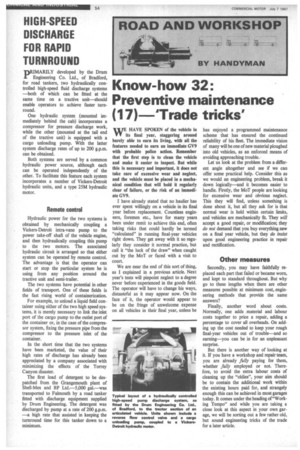Remote control
Page 56

If you've noticed an error in this article please click here to report it so we can fix it.
Hydraulic power for the two systems is obtained by mechanically coupling a Vickers-Detroit intra-vane pump to the power take-off shaft of the vehicle engine, and then hydraulically coupling this pump to the two motors. The associated hydraulic circuit is arranged so that either system can be operated by remote control. The advantage is that the operator can start or stop the particular system he is using from any position around the tractive unit and semi-trailer.
The two systems have potential in other fields of transport. One of these fields is the fast rising world of containerization.
For example, to unload a liquid field container using either of the two high speed systems, it is merely necessary to link the inlet port of the cargo pump to the outlet port of the container or, in the case of the compressor system, fixing the pressure pipe from the compressor to the pressure inlet of the container.
In the short time that the two systems have been marketed, the value of their high rates of discharge has already been appreciated by a company associated with minimizing the effects of the Torrey Canyon disaster.
The first load of detergent to be despatched from the Grangemouth plant of Shell-Mex and BP Ltd.-5,000 gal.—was transported to Falmouth by a road tanker fitted with discharge equipment supplied by Drum Engineering. The detergent was discharged by pump at a rate of 200 g.p.m. —a high rate that assisted in keeping the tumround time for this tanker down to a minimum.




































































































































